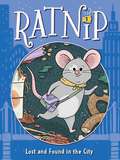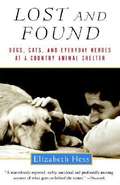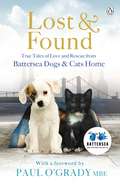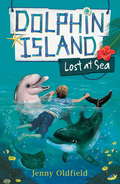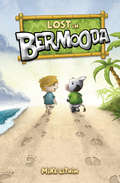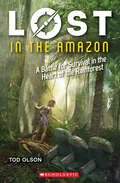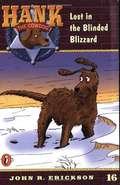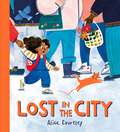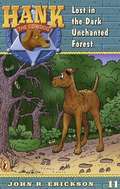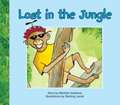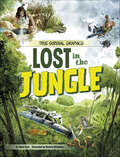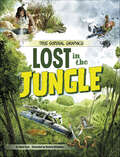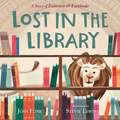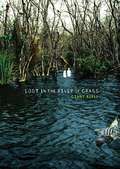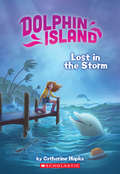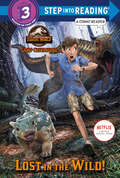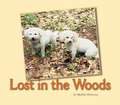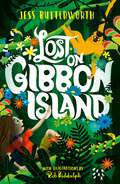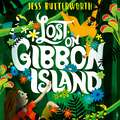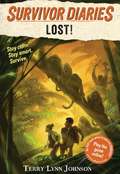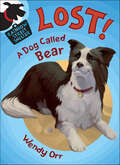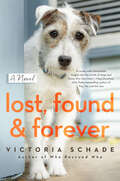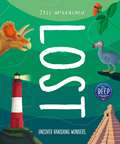- Table View
- List View
Lost and Found in the City (Ratnip #1)
by Cam HigginsIn this first book of the new chapter book series from the author of Good Dog, meet Ratnip, an adorable rat who goes on adventures in the city that are equal parts sweet and icky!Ratnip the rat lives in the City, where there&’s always plenty of food to eat…if you know where to look. Dumpster diving isn&’t just for finding food, though. It&’s also for discovering knick-knacks and adventure! And tonight, Ratnip is on a very special mission to return treasure to its rightful owner. But will he make it home before sunrise? With easy-to-read language and illustrations on almost every page, the Ratnip chapter books are perfect for beginning readers.
Lost and Found: Dogs, Cats, and Everyday Heroes at a Country Animal Shelter
by Elizabeth HessIn Lost and Found, Hess brings you behind the scenes in this thorough examination of the day-to-day workings of the shelter.
Lost and Found: True tales of love and rescue from Battersea Dogs & Cats Home
by Battersea Dogs & Cats HomeIn the heart-warming Lost and Found, discover tales from Battersea Dogs & Cats Home that celebrate the power of animals to transform people's lives.We hear from the young boy whose Battersea dog helped him to deal with a serious autoimmune disease, and from a woman whose Staffie was the friend who got her through cancer. We meet the couple who were brought together by a Battersea dog; the man who took on a three-legged kitten which changed his life; and the former Battersea hound who became a search and rescue dog.Read these and many other powerful stories from Battersea Dogs & Cats Home. Lost and Found has something for dog and cat lovers alike, and is perfect reading for fans of A Streetcat Named Bob and Paul O'Grady's For The Love Of Dogs.Battersea Dogs & Cats Home is the UK's oldest and most famous home for dogs and cats. The Home aims never to turn away a dog or cat in need of help, reuniting lost dogs and cats with their owners or caring for them until new homes can be found. Battersea also works to educate the public about responsible pet ownership. Every year the Home cares for over 9,000 lost, abandoned and neglected dogs and cats, and in 2010 the home marked its 150th anniversary.
Lost at Sea: Book 2 (Dolphin Island #2)
by Jenny OldfieldA family marooned on an island finds loveable dolphins to help them survive: classic adventure from million-copy-selling Jenny Oldfield. Shipwrecked near a tiny island in a vast ocean, the Fisher family are guided to safety by a small pod of dolphins. Fleur, Alfie, Mia and their parents must learn to build shelter, find fresh water and hunt for food. Each of the children forms a special bond with one of the family of dolphins. Fleur adores the fun-loving, tail-walking Jazz. Mia names her dark-grey dolphin friend Stormy. And Alfie is saved from the shipwreck by Pearl, who always looks out for him. But the children's father is ill! While Fleur and Mia explore the dark forest and search the beaches for precious equipment from the shipwreck, Alfie has his own plans ... and perhaps only Pearl can save him from himself ...Jenny Oldfield strikes gold in this beautifully illustrated, exciting adventure story, the second in the Dolphin Island series.The full series: Shipwreck, Lost at Sea, Survival, Fire!, Missing, Storm Clouds.
Lost in Bermooda
by Mike LitwinBermooda is a tropical island that is undiscovered by the outside world and is primarily populated by walking, talking cows of human intelligence. The cows came to the island hundreds of years ago by a ship carrying livestock that wrecked upon the shoals around the southern tip of the island. They have since formed their own quaint, mootopian tropical island society.Life is good on Bermooda, and the residents are mostly content to be unknowing of and unknown to the world beyond their horizons. Bermooda has no "outsiders," and most prefer to keep it that way. That is, until Chuck ventures into the boneyard alone and discovers a young human boy who has been washed up unconscious on the sandbar! The young boy's name is Dakota and he doesn't seem as scary as Chuck thought humans would be. Chuck decides to "cow-mouflage" Dakota to pass as a bovine in town. Dakota and Chuck become fast friends, but trouble is brewing and Dakota's true identity is at risk of being discovered. In the end, Chuck's family adopts Dakota as their own calf.
Lost in Snow (Pet Finders Club #11)
by Ben M. BaglioTeddy falls off his place on the window ledge and has a snowy adventure until a kind man in a red suit helps him find his way home.
Lost in the Amazon: A Battle for Survival in the Heart of the Rainforest (Lost #3)
by Tod OlsonIn this true story written for young readers, a teen is the only survivor of a plane crash and must stay alive in the South American jungle until rescue.Peru, Christmas Eve, 1970. It was supposed to be a routine flight, carrying eighty-six passengers across the Andes Mountains and home for the holiday. But high above the Amazon rainforest, a roiling storm engulfs the plane. Lightning strikes. A deafening whoosh sweeps through the cabin. And suddenly, seventeen-year-old Juliane Koepcke is alone. The plane has vanished. She is strapped to her seat and plunging 3,500 feet to the forest floor. On Christmas Day, she wakes. She is injured, covered in mud, but strangely—miraculously—alive. And now, in a remote corner of the largest rainforest on Earth, the real battle for survival begins.
Lost in the Blinded Blizzard (Hank the Cowdog Series, #16)
by John R. EricksonA blizzard shuts down the ranch and Hank is stranded in Slim's cabin. When someone has to deliver Slim's cough medicine to Baby Molly and Slim's truck gets stuck, it's up to Hank.
Lost in the City
by Alice CourtleyA charming and heartfelt tale of adventure about finding your self-confidence with a brilliant spot-and-find theme. From the exciting debut author-illustrator, Alice Courtley. Maya loves her small perfect family - it's just her, Granny and their little kitten Sammy in their perfect peaceful house. So when Granny announces they are going on a big adventure to the city, Maya is scared. She's too small for the city, surely? And what about Sammy?When they arrive amongst the towering grey buildings, Maya discovers that Sammy has followed them! And when he escapes, Maya must face her fears and look after him. A fun and adventurous story about getting out of your comfort zone and how the love and support of family can help you achieve almost anything.
Lost in the Dark Unenchanted Forest (Hank the Cowdog Series, #11)
by John R. EricksonWhen Little Alfred runs away from home and winds up in the Dark Unenchanted Forest being trailed by a bobcat, Hank knows it's up to him to save his young master.
Lost in the Jungle (True Survival Graphics)
by Steve FoxeA teenager wanders alone through the jungle in Peru. A woman loses her way in an Australian rain forest. A pilot crash-lands in the Amazon. These remarkable true tales could have ended in tragedy—but they didn’t! What happened to three people who found themselves wandering for weeks though dense jungles? And how did they survive to tell their tales? Young readers will find out in this easy-to-read hi-lo graphic novel that will keep them on the edge of their seats!
Lost in the Jungle (True Survival Graphics)
by Steve FoxeA teenager wanders alone through the jungle in Peru. A woman loses her way in an Australian rain forest. A pilot crash-lands in the Amazon. These remarkable true tales could have ended in tragedy—but they didn’t! What happened to three people who found themselves wandering for weeks though dense jungles? And how did they survive to tell their tales? Young readers will find out in this easy-to-read hi-lo graphic novel that will keep them on the edge of their seats!
Lost in the Library: A Story of Patience & Fortitude (A New York Public Library Book)
by Josh FunkSteadfast Fortitude and curious Patience are waiting every morning to greet visitors of the Library.That is until, one early morning, when Fortitude finds Patience is missing. The city is about to awake, and the lions absolutely must be in their places before the sun rises. Now, Fortitude must abandon his own post to find his best friend in the Library’s labyrinthine halls.With Josh Funk's clever rhymes and Steview Lewis' vibrant art, Lost in the Library introduces young readers to a pair of unforgettable lions, as well as the famed New York Public Library, and includes bonus material loaded with facts about Patience, Fortitude, and the NYPL's history.
Lost in the River of Grass
by Ginny RorbyLost in a River of Grass is in the tradition of survival stories like Hatchet or On My Side of the Mountain, where the young protagonist finds herself as she struggles to survive in an unforgiving wilderness. In this case, the setting is the Everglades, and Sarah, the 13-year-old narrator, sneaks away from an overnight school field trip for what was supposed to be a quick airboat ride with Andy, a boy who lives in the preserve. Naturally, disaster strikes and theyre forced to walk out of the Everglades (theyve got a knife, a small amount of Gatorade and some suspicious Spam). The author also skillfully layers in a story about overcoming prejudice. Sarah is black and Andy is the son of a Confederate-flag waving self-described redneck.
Lost in the Storm (Dolphin Island #2)
by Catherine HapkaWelcome to Dolphin Island, where the tropical sun shines, the dolphins play, and friendship is always just down the beach!Hurricane season is here and Abby can't help but worry about the danger it may bring to the resort and the dolphins living in the cove. If the wind gets any stronger and the waves grow any wilder, everyone might have to evacuate!That doesn't stop Abby from introducing a new guest named Delaney to her dolphin friends. But when the storm hits and Delaney's dad gets stranded in open water, it's Abby and her dolphin friends to the rescue!
Lost in the Wild! (Step into Reading)
by Steve BehlingThis Step into Reading Step 3 Comic Reader is based on the hit Netflix hit show Jurassic World: Camp Cretaceous!Bonus content: Full-color poster!Jurassic World: Camp Cretaceous follows a group of six teenagers chosen for a once-in-a-lifetime experience at a new adventure camp on the opposite side of Isla Nublar--the home of the Jurassic World theme park. But when dinosaurs wreak havoc across the island, the campers are stranded. Perfect for boys and girls ages 5 to 8, this Step 3 Step into Reading leveled reader is illustrated with action-packed comic panels that showcase the fearsome dinosaurs from the show--plus a fold-out Jurassic World: Camp Cretaceous poster!Step 3 readers feature engaging characters in easy-to-follow plots about popular topics for children who are ready to read on their own.
Lost in the Woods
by Michèle DufresneRosie, the nervous and worried dog, thinks she and Bella are lost in the woods.
Lost on Gibbon Island
by Jess ButterworthThe Last Bear meets The Life of Pi in this adventure-filled survival story set on a lush Cambodian island! Meet 12-year-old Lark, who finds herself ship-wrecked with no one but a baby gibbon for company. Can she survive storms, lack of food and jelly-fish infested waters and find her way home?'If you're reading this, hopefully you've come to rescue me. My name is Lark Taylor, and I've been shipwrecked on an island. The last mainland I was on was Cambodia, miles and miles away from home...'When Lark's mum takes her family with her on a research trip to Cambodia, Lark never expects that she'll end up stranded on a deserted island! But that's exactly what happens when her boat is shipwrecked.With her only companion a baby gibbon, Lark faces many dangers - brutal storms, scorching sunshine and jellyfish-infested waters. And with dwindling food and water, she must make a plan to find her way off the island before it's too late...Formatted as Lark's diary with lined journal pages, gorgeous design details and a special map of Gibbon Island by Rob Biddulph, this is a gorgeous survival story that will have you on the edge of your seat.
Lost on Gibbon Island
by Jess ButterworthThe Last Bear meets The Life of Pi in this beautifully-written survival story set on a Cambodian island, following a ship-wrecked girl named Lark, and a baby gibbon who becomes her companion. Together, they must evade poachers and find their way home.'If you're reading this, hopefully you've come to rescue me. My name is Lark Taylor, and I've been shipwrecked on an island. The last mainland I was on was Cambodia, miles and miles away from home...'When Lark's mum takes her family with her on a research trip to Cambodia, Lark never expects that she'll end up stranded on a deserted island, with no one but a baby gibbon for company. But that's exactly what happens. Lost and with no idea how to survive in the jungle, Lark must learn the ways of the wild from the gibbon. And in return, try to help the gibbon find her way home ...
Lost! (Survivor Diaries)
by Terry Lynn Johnson Jani OrbanA high-stakes survival series perfect for fans of the I Survived series and Hatchet. Stay calm. Stay smart. Survive. An ancient myth about a statue leads eleven-year-old Carter and twelve-year-old Anna down a trail deep into the Costa Rican jungle. They get turned around, then chased by howler monkeys. Carter and Anna try to find their way back to the familiar path, but the tangle of vines and trees all look the same. They are . . . lost! With seventeen years of hands-on experience and training in remote areas, survival expert Terry Lynn Johnson(Ice Dogs; Sled Dog School) creates on-the-edge-of-your-seat storytelling featuring real skills to prepare kids for surviving a disaster. This book includes tips from the Canadian Red Cross on how to make your own survival kit. After reading this book, you'll be better prepared for surviving a real-life disaster.
Lost! A Dog Called Bear (Rainbow Street Shelter #1)
by Wendy OrrLogan is moving from the farm to the city. He'll miss all the things he's leaving behind, but at least he has Bear. He loves Bear more than anything else in the world—because Bear is his dog. Hannah lives in the city. What she wants, more than anything else in the world, is a dog of her own. At the Rainbow Street Shelter, Logan and Hannah find a talking parrot, an old black Labrador, a three-legged goat, a puppy that looks like a peanut—and a Surprise that just might be the best thing in the world.
Lost, Found, and Forever
by Victoria SchadeWhat do you do when you discover your four-legged best friend might belong to someone else? From the acclaimed author of Who Rescued Who comes the charming story of a custody battle between two pet parents who would do anything for the dog they both adore. Justine Becker could not be more in love with her rescue dog, Spencer. He's her best friend and "colleague" at her dog supply store, Tricks & Biscuits, in upstate New York. When she discovers a heartbreaking social media post trying to locate a dog that looks suspiciously like Spencer, Justine realizes that her beloved pup might actually belong to someone else. Her worst fears are realized when she and Spencer meet up with Brooklyn-based Griffin McCabe, and he wants Spencer back. He claims he is the dog's rightful owner, and has the paperwork to prove it. But Justine refuses to roll over and let him take Spencer without a fight. It&’s not easy juggling Spencer's burgeoning new career as a dog actor, along with the demands of her life upstate, all while constantly trying to prove she's a better pet parent than Griffin. Their not-so-friendly competition teeters on the edge of flat-out hate, so when romantic feelings for Griffin catch Justine off guard, she needs to determine if it's all part of his plot to win the pup back, or if the guy who was good enough for Spencer might also be good enough for her.
Lost: Discover disappearing wonders
by Jess McGeachinA book that explores what it means to be lost, in all sorts of ways. The story of our world is one of constant change. At times it's been slow, as animals evolved and continents drifted apart. But it's also been rapid - like the giant asteroid that ended the reign of the dinosaurs. Lost asks readers what it means to be here and gone on our tiny planet. They'll find lost cities like Machu Picchu and Pompeii, meet amazing megafauna that once roamed the earth and learn about contemporary species under threat. They'll discover that sometimes being lost the safest place to be - just ask the cleverly camouflaged animals hiding in plain sight.
Lots and Lots of Zebra Stripes
by Stephen R. SwinburneWith a simple text and vivid full-color photographs, Stephen R. Swinburne shows children a wide range of nature's exquisite designs. He invites children to open their eyes and look for patterns in water and on land, in the air and on the ground, and in their own neighborhoods. They will see the world as they've never seen it before.
